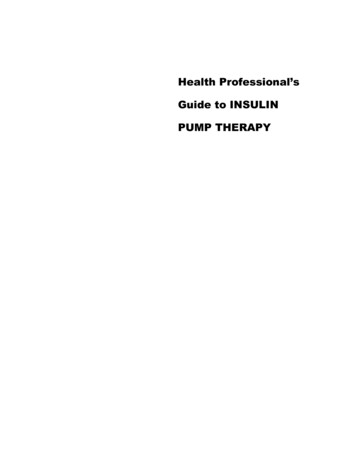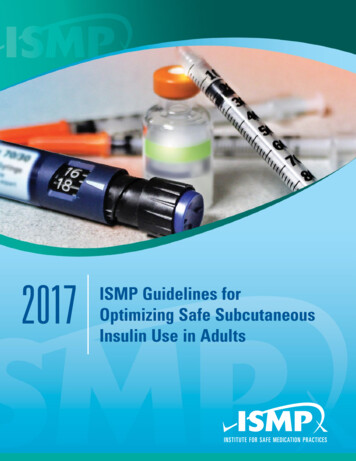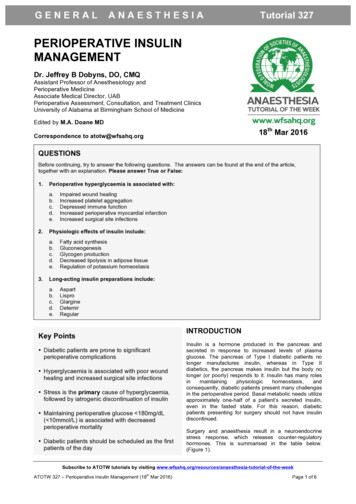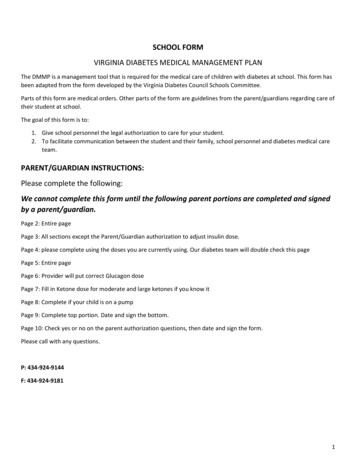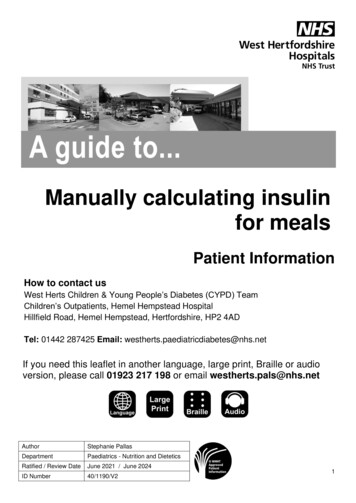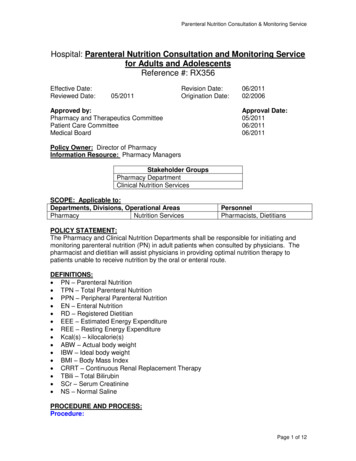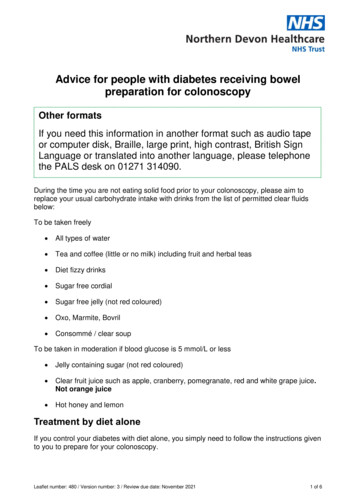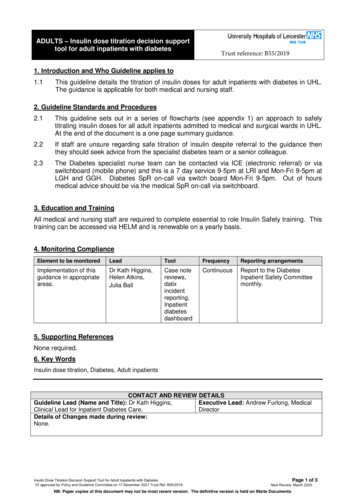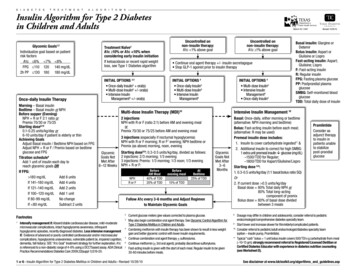
Transcription
D I A B E T E ST R E A T M E N TA L G O R I T H M SInsulin Algorithm for Type 2 Diabetesin Children and AdultsGlycemic Goals1,2Individualize goal based on patientrisk factorsA1c 6% 7% 8%FPG 110 120 140 mg/dL2h PP 130 180 180 mg/dLOnce-daily Insulin TherapyMorning – Basal insulinBedtime – Basal insulin or NPHBefore supper (Evening)NPH R or F 2:1 ratio orPremix 70/30 or 75/25Starting dose9,100.1-0.25 units/kg/day or6-10 units/day if patient is elderly or thinAchieving GoalsAdjust Basal insulin / Bedtime NPH based on FPGAdjust NPH R or F / Premix based on bedtimeglucose and FPGTitration schedule9Add 1 unit of insulin each day toreach glycemic goals ORIf FPG: 180 mg/dLAdd 6 unitsIf 141–180 mg/dL Add 4 unitsIf 121–140 mg/dL Add 2 unitsIf 100–120 mg/dL Add 1 unitIf 80-99 mg/dLNo changeIf 80 mg/dLSubtract 2 unitsUncontrolled onnon-insulin therapy:A1c 1% above goalUncontrolled onnon-insulin therapy:A1c 1% above goalTreatment NaïveA1c 10% or A1c 10% whenconsidering early insulin initiationIf ketoacidosis or recent rapid weightloss, see Type 1 Diabetes algorithm Continue oral agent therapy /- insulin secretagogue Stop GLP-1 agonist prior to insulin therapyINITIAL OPTIONS 3,4 Once-daily Insulin5 oral(s) Multi-dose Insulin6 /- oral(s) Intensive InsulinManagement6 /- oral(s)INITIAL OPTIONS 4 Once-daily Insulin5 Multi-dose Insulin6 Intensive InsulinManagement63INITIAL OPTIONS 4 Multi-dose Insulin6 Intensive InsulinManagement6 Once-daily Insulin5Intensive Insulin Management 102 injectionsNPH with R or F (ratio 2:1) before AM and evening mealorPremix 70/30 or 75/25 before AM and evening mealBasal: Once-daily, either morning or bedtime(alternative: NPH morning and bedtime)Bolus: Fast-acting insulin before each meal;(alternative: R may be used)Premeal insulin dose includes:1. Insulin to cover carbohydrate ingested11 &2. Additional insulin to correct for high SMBG:1 extra unit premeal insulin â glucose (mg/dL) 1500/TDD for Regular; 1800/TDD for Aspart/Glulisine/LisproStarting dose 8,9:1. 0.3-0.5 units/kg/day (1:1 basal:bolus ratio SQ)Or2. If current dose 0.5 units/kg/dayBasal dose 80% Total daily NPH or80% Total long-actingcomponent of premixBolus dose 80% of basal dose dividedbetween 3 meals3 injections (especially if nocturnal hypoglycemia)NPH with R or F morning; R or F7 evening; NPH bedtime orPremix (as above) morning, noon, eveningGlycemicGoals NotMet After6–12 WeeksStarting dose8,9: 0.3-0.5 units/kg/day, divided as follows:2 injections: 2/3 morning; 1/3 evening3 injections: Premix: 1/3 morning; 1/3 noon; 1/3 eveningNPH R or F:Intensify management if: Absent/stable cardiovascular disease, mild-moderatemicrovascular complications, intact hypoglycemia awareness, infrequenthypoglycemic episodes, recently diagnosed diabetes. Less intensive managementif: Evidence of advanced or poorly controlled cardiovascular and/or microvascularcomplications, hypoglycemia unawareness, vulnerable patient (ie, impaired cognition,dementia, fall history). SEE “A1c Goal” treatment strategy for further explanation. A1cis referenced to a non-diabetic range of 4-6% using a DCCTbased assay. ADA ClinicalPractice Recommendations Diabetes Care 2009;32(suppl 1):S19-20.NPHR or FBeforeAM Meal40% of TDD20% of TDDBeforeevening mealAtBedtime25% of TDDGlycemicGoals NotMet After3–6Months15% of TDDFollow A1c every 3-6 months and Adjust Regimento Maintain Glycemic Goals234567Current glucose meters give values corrected to plasma glucose.May also begin combination oral agent therapy. See Glycemic Control Algorithm forType 2 Diabetes Mellitus in Children and Adults.Combining metformin with insulin therapy has been shown to result in less weightgain and better glycemic control with lower insulin requirements.Continue combination oral agent therapy sulfonylurea.Continue metformin ( 3rd oral agent); probably discontinue sulfonylurea.Fast-acting insulin is given with the start of each meal. Regular insulin to be given30-60 minutes before meals.1 of 6 – Insulin Algorithm for Type 2 Diabetes Mellitus in Children and Adults – Revised 10/28/10891011Revised 10/28/10Basal insulin: Glargine orDetemirBolus insulin: Aspart orGlulisine or LisproFast-acting insulin: Aspart;Glulisine; LisproF: Fast-acting insulinR: Regular insulinFPG: Fasting plasma glucosePP: Postprandial plasmaglucoseSMBG: Self-monitored bloodglucoseTDD: Total daily dose of insulinMulti-dose Insulin Therapy (MDI)10Footnotes1Stock # 45-11647PramlintideConsider asadjunct therapyto insulin inpatients unableto stabilizepost-prandialglucoseDosage may differ in children and adolescents; consider referral to pediatricendocrinologist/comprehensive diabetes specialty team.Start lower and increase slower for thin/elderly/complicated patients.Consider referral to pediatric/adult endocrinologist/diabetes specialty team(option – insulin pump, Pramlintide).Typical “carb” bolus 1 unit bolus insulin covers 500/TDI x g carbohydrate from meal( 10-15 gm); strongly recommend referral to Registered/Licensed Dietitian orCertified Diabetes Educator with experience in diabetes nutrition counseling(see Worksheet D).See disclaimer at www.tdctoolkit.org/algorithms and guidelines.asp
D I A B E T E ST R E A T M E N TA L G O R I T H M SInitiation of Once Daily Insulin Therapy for Type 2 Diabetes Mellitusin Children and AdultsGlycemic Goals1,2Individualize goal based on patientrisk factorsA1c 6% 7% 8%FPG 110 120 140 mg/dL2h PP 130 180 180 mg/dLInsulins and AbbreviationsTreatment Naïve3A1c 10% or DKA - Start insulinOral Agent Failure; A1c above targetStock # 45-11647Revised 04/28/16AbbreviationsFPG: Fasting plasma glucoseSMBG: Self-monitored blood glucosePP: Postprandial plasma glucoseInitiate insulin therapy with daily basal or bedtime NPH6BASALLantus (glargine U100)Levemir (detemir)Beginning dosage: 10 units or 0.1–0.25 units/KgToujeo (glargine U300)3Tresiba (degludec U100, U200)3Suggested Titration Schedule – Adjust Every 2-3 DaysBOLUS (Prandial)Reg (Regular insulin U100, U500)If FPG:RAI Rapid-Acting InsulinApidra (glulisine) 180 mg/dlif 141–180 mg/dlif 121–140 mg/dlif 80-120 mg/dlif 80 mg/dlHumalog (lispro U100, U200)Novolog (aspart U100)IAI’s (Intermediate-acting insulins)Humulin N (NPH)Add 6 unitsORAdd 4 unitsAdd 2 unitsNo changeSubtract 2 unitsAdd 1 unit insulin each dayuntil fasting SMBG is at goalHumulin R (Regular U500)Novolin N (NPH)PREMIX3Humalog Mix (lispro protamine/lispro 75/25)if A1c remains A1c goal over 3 months, discontinue oral secretagogue, continue oral insulinsensitizer(s) and initiate multi-dose insulin or intensive insulin therapy1 or consult an endocrinologistHumulin (NPH/Reg 70/30)Novolin (NPH/Reg 70/30)NovoLog Mix (aspart protamine/aspart 70/30)Footnotes1For the complete approach to insulin initiation in type 2 diabetes, seeInsulin Algorithm for Type 2 Diabetes in Children and Adults.2Intensify management if: absent/stable cardiovascular disease,mild-moderate microvascular complications, intact hypoglycemiaawareness, infrequent hypoglycemic episodes, recently diagnoseddiabetes. Less intensive management if: evidence of advanced orpoorly controlled cardiovascular and/or microvascular complications,hypoglycemia unawareness, vulnerable patient (ie, impairedcognition, dementia, fall history). See “A1c Goal” treatment345strategy for further explanation. A1c is referenced to a non-diabeticrange of 4-6% using a dcct-based assay. AdA clinical practicerecommendations. Diabetes Care 2009;32(suppl 1):s19-20.Not FDA approved for Children.Usually with an insulin secretagogue (sulfonylurea, repaglinide ornateglinide) and sensitizer (metformin or thiazolidinedione). SeeGlycemic Control Algorithm.The pharmacokinetic profile of npH compared to that of glargineor detemir is less predictable, therefore can result in blood sugar2 of 6 – Initiation of Once Daily Insulin Therapy for Type 2 Diabetes Mellitus in Children and Adults – Revised 4/28/16678variations and increased nocturnal hypoglycemia. cost of glargine ordetemir is 1.5-2 times that of npH. lispro 75/25 or Aspart 70/30 canbe considered at pre-supper adjusting dosage according to Hs andfasting sMbG.IMPORTANT: See package insert for dosing.If daytime hypoglycemia develops, contact healthcare professional.Current glucose meters give values corrected to plasma glucose.See disclaimer at www.tdctoolkit.org/algorithms and guidelines.asp
D I A B E T E ST R E A T M E N TA L G O R I T H M SWorksheet: Advancing to Intensive/Physiologic Basal:Bolus Insulin TherapyStock # 45-11647Revised 1/27/10Note: “Analog” Rapid Acting (Bolus) Analog insulin throughout this document.A. Conversion from once-daily insulin to intensive/physiologic insulin replacement:Oral therapy failure: Once-daily glargine was added to the oral regimen and titrated to 30 units per day. How do you add analog insulin if the patientreports the following SMBG values?FPG2-HR PPBRKFT2-HR PPLUNCH2-HR PPDINNERCase 1105140140240Case 2105140190240Case 3105190240240Case 1a. Continue the oral agents ( sulfonylurea) and 30 units glargine or detemir (or NPH)b. There are 2 approaches for adding analog (RAI) 10-15 minutes before a meal:#1 Arbitrary start:Titrate:5 unitsAdd 2 units every 2 days to reach 2-hr pp goal#2 Carb-counting1 unit/50 mg/dL over 2-hr pp goalPLUSTitrate:1 unit/15 grams carbohydrateAdd 1 unit/50 mg/dL 2-hr pp goal every 2 daysCases 2 and 3As above, but add and titrate analog before each meal where the postprandial glucose is above goal. Also, see part D below for more information on howto optimize the use of analog insulin. Re-evaluate each week to be certain that about half of the total daily dose is basal and half is bolus insulin.B. Conversion from once-daily premix to intensive/physiologic insulin replacement:Oral therapy failure: Once-daily 70/30 premixed insulin was added and titrated to 30 units per day. The fasting glucose is at goal, but daytimecontrol is poor. How do you convert to physiologic insulin therapy?3 of 6 – Worksheet: Advancing to Intensive/Physiologic Basal: Bolus Insulin Therapy – Revised 1/27/10See disclaimer at www.tdctoolkit.org/algorithms and guidelines.asp
D I A B E T E Sa.T R E A T M E N TA L G O R I T H M SBasal insulin dose: The first step in the conversion is based on the total dose of intermediate-acting insulin. In this case, the person is taking 21units of NPH or aspart-protamine insulin (70% x 30 units 21 units). So, give 21 units basal glargine (use “unit-for-unit” conversion for oncedaily intermediate regimens). Remember, do not stop oral agents ( sulfonylurea) at this time.b. Bolus insulin dose: There are several ways to start the analog.i. See Case 1 (Arbitrary start or Carb-counting)ii. Begin with the previous dose of fast-acting insulin, divide it before meals and titrate every 2 days. In this case, the person was using30 units of 70/30 or about 9 units of fast-acting insulin (30% x 30 units 9 units). So give 3 units of analog before each meal andtitrate every 2 days as per Case 1.C. Conversion from twice-daily premix to intensive/physiologic insulin replacement:Oral therapy failure in an 80 kg person: 70/30 premixed insulin was started and advanced to 60 units per day: 40 units before breakfast and 20 unitsbefore dinner. The fasting glucose was at goal, but wide glycemic excursions occurred at other times during the day and night. How do you convertthis person to physiologic insulin therapy? There are several approaches. Use which ever method you want.a.Start over and begin insulin at 0.5 units/kg. Give half as basal insulin and half as analog, divided before meals. In this case, the startingdose would be 40 units per day. Start giving 20 units glargine each morning and about 7 units analog before each meal. Titrate the basaland bolus insulins every 2 days to fasting and 2-hr postprandial goals.b. Conversion based on current insulin usage:Basal dose: The first step in the conversion is based on the 80% of the total dose of intermediate-acting insulin. In this case, theperson is taking 42 units of NPH or aspart-protamine insulin (70% x 60 units 42 units). When a person is taking multiple doses ofintermediate-acting insulin, we give only 80% as glargine. So, give 34 units basal glargine (80% x 42 34). Remember, do not stop oralagents ( sulfonylurea) at this time.Bolus insulin dose: There are several ways to start the analog.i. See Case 1 (Arbitrary start or Carb-counting)ii. Begin with the previous dose of fast-acting insulin, divide it before meals and titrate every 2 days. In this case, the person was using60 units of 70/30 or 18 units of fast-acting insulin (30% x 60 units 18 units). So, give 6 units of analog before each meal andtitrate every 2 days as per Case 1.c.The “80%-80%”rule: Similar to the above method, but yields an ideal ratio of basal:bolus insulin in one step. The dose of basal glarginewill be 80% of the total intermediate insulin, and the analog will be 80% of the glargine dose, divided before meals.4 of 6 – Worksheet: Advancing to Intensive/Physiologic Basal: Bolus Insulin Therapy – Revised 1/27/10See disclaimer at www.tdctoolkit.org/algorithms and guidelines.asp
D I A B E T E ST R E A T M E N TBasal dose:A L G O R I T H M S 80% of total intermediate insulin 80% x 42 units (70% x 60 42) 34 units glargineAnalog dose: 80% of the glargine dose, divided TID80% x 34 units 27 units27 units, divided TID 9 units9 units aspart, glulisine or lispro before mealsNote: Total dose of insulin is conserved and an ideal ratio between basal and bolus will always result with the “80%-80%” method.D. Optimizing analog insulin useTight control of blood glucose requires that the patient participates in the management of their diabetes. This includes monitoring their bloodglucose and learning to count carbohydrates or “carb count.” The following material explains how to calculate the dose of analog required to covera meal and how to add extra analog to correct a hyperglycemic event.a.Determining the dose of analog insulin to use before a mealThe “Rule of 500” is used to determine how many grams of carbohydrate 1 unit of analog insulin will cover. When this number isknown, then the person can easily give the correct dose of analog by simply counting the grams of carbohydrate they intend to eat at themeal.Specifically, 500 divided by the total daily insulin dose (500/TDI) yields the number of grams of carbohydrate that 1 unit of analog willcover. For example, if a person has established that they require about 50 units of insulin per day, then it follows that 1 unit of analog willcover 10 grams of carbohydrate (500/50 10). If the person carb counts 140 grams in the dinner meal, then the dose of analog will be 14units given 10 minutes before eating.b. Correcting for hyperglycemiaThe “Rule of 1800” is used to determine how much insulin to use to bring a high glucose reading back to goal. Even with tight control,hyperglycemia occurs and people need to be able to correct this situation.Specifically, 1800 divided by the total daily insulin dose yields a value indicating how much 1 unit of analog insulin will lower the bloodglucose. Thus, if a person uses 90 units of insulin per day, then 1 unit of analog will reduce the blood glucose by 20 mg/dL(1800/90 20). This augment dose of insulin can be used by itself to correct hyperglycemia, or added to the bolus dose if glucose ishigh before a meal.5 of 6 – Worksheet: Advancing to Intensive/Physiologic Basal: Bolus Insulin Therapy – Revised 1/27/10See disclaimer at www.tdctoolkit.org/algorithms and guidelines.asp
D I A B E T E ST R E A T M E N TA L G O R I T H M SReferences1. Riddle MC, Rosenstock J, Gerich J. Diabetes Care. 2003; 26:3080-3086.2. Spellman CW, Renda SM, Davis SN. Realizing the Potential of Insulin Therapy in Type 2 Diabetes: A Case Presentation-Based Monograph. presented at the American College ofOsteopathic Internists 64th Annual Convention; Chicago, IL (September 30, 2004).3. www.texasdiabetescouncil.org.Reviews/Important ArticlesMultiple Dose Insulin Regimens (2-shot Regimens) Abraira C, Colwell J, Nuttall F, et al. Cardiovascular events and correlates in the VeteransAffairs Diabetes Feasibility Trial. Veterans Affairs Cooperative Study on Glycemic Control andComplications in Type II Diabetes. Arch Intern Med. 1997;157(2):181-8.NPH/Regular vs. NPH/ short acting analogue therapy Anonymous. Intensive blood-glucose control with sulphonylureas or insulin compared withconventional treatment and risk of complications in patients with type 2 diabetes (UKPDS 33). UKProspective Diabetes Study (UKPDS) Group. Lancet. 1998;352(9131):837-53. DeWitt DE, Dugdale DC. Using new insulin strategies in the outpatient treatment of diabetes:clinical applications. JAMA. 2003;289(17):2265-9. DeWitt DE, Hirsch IB. Outpatient insulin therapy in type 1 and type 2 diabetes mellitus: scientificreview. JAMA. 2003;289(17):2254-64. Implementation Conference for ACE Outpatient Diabetes Mellitus Consensus ConferenceRecommendations: Position Statement, February 2, 2005. Available online at tatement.pdf. Accessed on May 2, 2005. Hirsch IB. Insulin analogues. N Engl J Med. 2005;352(2):174-83.Once Daily InsulinMorning vs. Bedtime NPH Groop LC, Widen E, Ekstrand A, et al. Morning or bedtime NPH insulin combined withsulfonylurea in treatment of NIDDM. Diabetes Care. 1992;15(7):831-4.Morning vs. Bedtime Glargine Fritsche A, Schweitzer MA, Haring HU. Glimepiride combined with morning insulin glargine,bedtime neutral protamine hagedorn insulin, or bedtime insulin glargine in patients with type 2diabetes. A randomized, controlled trial. Ann Intern Med. 2003;138(12):952-9.NPH vs. Glargine Riddle MC, Rosenstock J, Gerich J. The treat-to-target trial: randomized addition of glargine orhuman NPH insulin to oral therapy of type 2 diabetic patients. Diabetes Care. 2003;26(11):3080-6.Once Daily vs. Twice Daily Regimen Raskin P, Allen E, Hollander P, et al. Initiating insulin therapy in type 2 diabetes: a comparison ofbiphasic and basal insulin analogs. Diabetes Care. 2005;28(2):260-5.6 of 6 – Worksheet: Advancing to Intensive/Physiologic Basal: Bolus Insulin Therapy – Revised 1/27/10 Vignati L, Anderson JH Jr, Iversen PW. Efficacy of insulin lispro in combination with NPH humaninsulin twice per day in patients with insulin-dependent or noninsulin-dependent diabetes mellitus.Multicenter Insulin Lispro Study Group. Clin Ther. 1997;19(6):1408-21.70% NPH/ 30% Regular vs. Humalog Mix 75/25 or Novolog Mix 70/30 Roach P, Yue L, Arora V. Improved postprandial glycemic control during treatment with HumalogMix25, a novel protamine-based insulin lispro formulation. Humalog Mix25 Study Group. DiabetesCare. 1999;22(8):1258-61. Boehm BO, Home PD, Behrend C, et al. Premixed insulin aspart 30 vs. premixed humaninsulin 30/70 twice daily: a randomized trial in type 1 and type 2 diabetic patients. Diabet Med.2002;19(5):393-9.Multiple Dose Insulin Regimens (3-shot Regimens) Ohkubo Y, Kishikawa H, Araki E, et al. Intensive insulin therapy prevents the progression ofdiabetic microvascular complications in Japanese patients with non-insulin-dependent diabetesmellitus: a randomized prospective 6-year study. Diabetes Res Clin Pract. 1995;28(2):103-17.Intensive Insulin Therapy Ohkubo Y, Kishikawa H, Araki E, et al. Intensive insulin therapy prevents the progression of diabeticmicrovascular complications in Japanese patients with non-insulin-dependent diabetes mellitus: arandomized prospective 6-year study. Diabetes Res Clin Pract. 1995;28(2):103-17. Saudek CD, Duckworth WC, Giobbie-Hurder A, et al. Implantable insulin pump vs multiple-doseinsulin for non-insulin-dependent diabetes mellitus: a randomized clinical trial. Department ofVeterans Affairs Implantable Insulin Pump Study Group. JAMA. 1996;276(16):1322-7. Raskin P, Bode BW, Marks JB, et al. Continuous subcutaneous insulin infusion and multiple dailyinjection therapy are equally effective in type 2 diabetes: a randomized, parallel-group, 24-weekstudy. Diabetes Care. 2003;26(9):2598-603. Bretzel RG, Arnolds S, Medding J, et al. A direct efficacy and safety comparison of insulin aspart,human soluble insulin, and human premix insulin (70/30) in patients with type 2 diabetes. DiabetesCare. 2004;27(5):1023-7.See disclaimer at www.tdctoolkit.org/algorithms and guidelines.asp
units of NPH or aspart-protamine insulin (70% x 30 units 21 units). So, give 21 units basal glargine (use "unit-for-unit" conversion for once-daily intermediate regimens). Remember, do not stop oral agents ( sulfonylurea) at this time. b. Bolus insulin dose: There are several ways to start the analog. i. See Case 1 (Arbitrary start or Carb .

